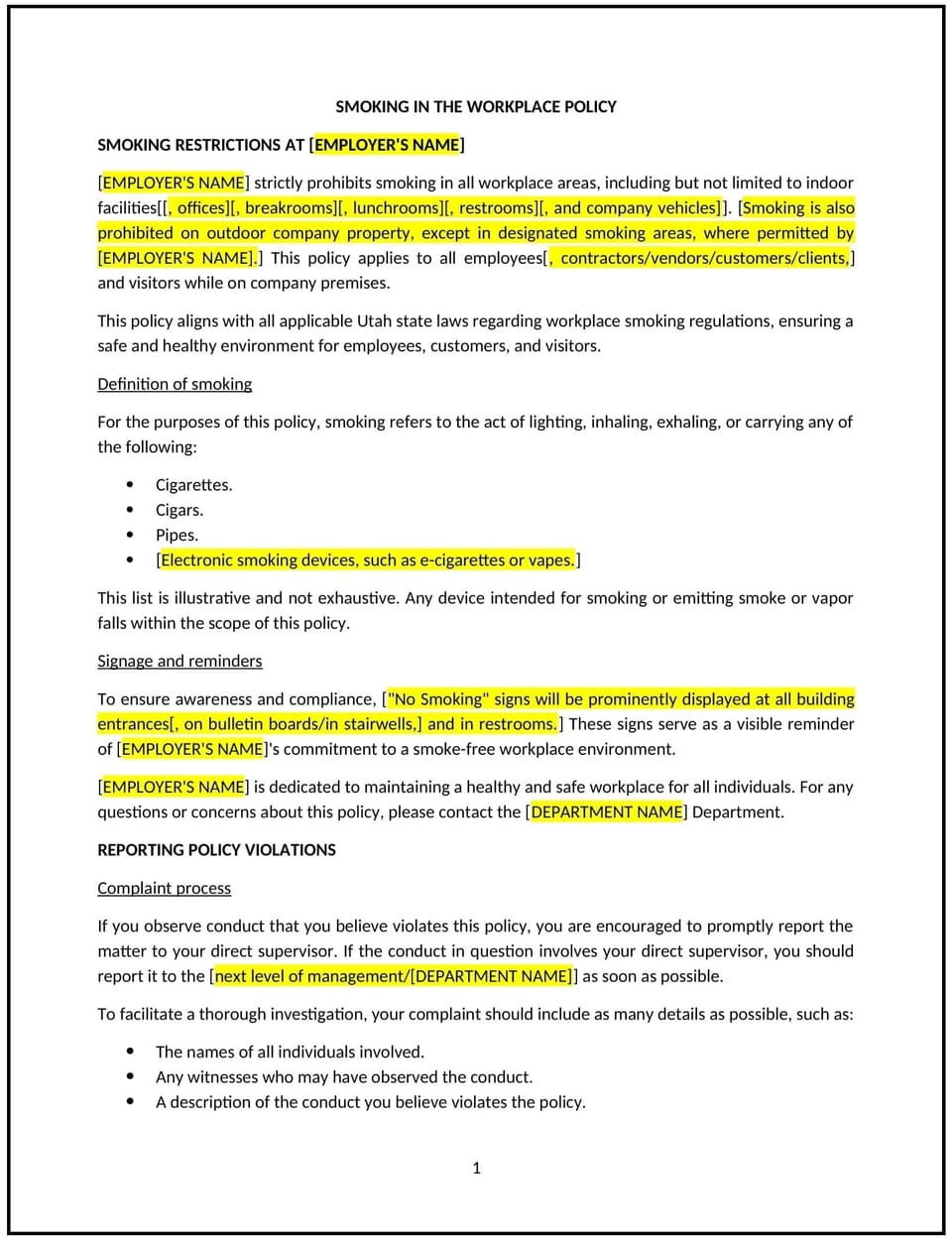Smoking in the workplace policy (Utah): Free template

Smoking in the workplace policy (Utah)
This smoking in the workplace policy is designed to help Utah businesses establish guidelines for smoking and tobacco use on company premises. It outlines designated smoking areas, restrictions, and compliance with state and local smoking laws.
By adopting this policy, businesses can promote a healthy work environment, reduce secondhand smoke exposure, and align with general best practices for workplace safety.
How to use this smoking in the workplace policy (Utah)
- Define smoking and tobacco use: Specify what constitutes smoking and tobacco use, including cigarettes, e-cigarettes, and vaping.
- Establish designated areas: Outline where smoking is permitted, such as outdoor areas away from building entrances.
- Prohibit smoking in non-designated areas: Specify that smoking is not allowed indoors or in other restricted areas.
- Address compliance: Ensure the policy aligns with Utah state laws and local smoking regulations.
- Provide resources: Offer information about smoking cessation programs or resources for employees.
- Train employees: Educate employees on the policy and the importance of maintaining a smoke-free workplace.
- Review and update: Assess the policy annually to ensure it aligns with evolving laws and workplace needs.
Benefits of using this smoking in the workplace policy (Utah)
This policy offers several advantages for Utah businesses:
- Promotes health: Reduces exposure to secondhand smoke and supports a healthier work environment.
- Aligns with legal standards: Helps businesses comply with Utah state laws and local smoking regulations.
- Enhances productivity: Minimizes smoking-related breaks and disruptions.
- Reduces fire risks: Lowers the risk of fires caused by smoking materials.
- Builds trust: Demonstrates a commitment to employee well-being and safety.
Tips for using this smoking in the workplace policy (Utah)
- Communicate the policy: Share the policy with employees and include it in the employee handbook.
- Provide training: Educate employees on the policy and the importance of maintaining a smoke-free workplace.
- Monitor compliance: Regularly review smoking areas and enforce restrictions in non-designated areas.
- Address violations promptly: Take corrective action if employees violate the smoking policy.
- Update regularly: Assess the policy annually to ensure it aligns with evolving laws and workplace needs.
Q: How does this policy benefit businesses?
A: By promoting a smoke-free workplace, businesses can enhance employee health, comply with laws, and reduce fire risks.
Q: What types of smoking are typically prohibited?
A: Prohibited smoking may include cigarettes, e-cigarettes, vaping, and other tobacco products in non-designated areas.
Q: How can businesses ensure compliance with the smoking policy?
A: Businesses should clearly mark designated smoking areas, enforce restrictions, and provide training on the policy.
Q: What should businesses do if an employee violates the smoking policy?
A: Businesses should address the violation promptly, enforce consequences, and provide additional training if necessary.
Q: How often should businesses review this policy?
A: Businesses should review the policy annually or as needed to ensure it aligns with evolving laws and workplace needs.
This article contains general legal information and does not contain legal advice. Cobrief is not a law firm or a substitute for an attorney or law firm. The law is complex and changes often. For legal advice, please ask a lawyer.


